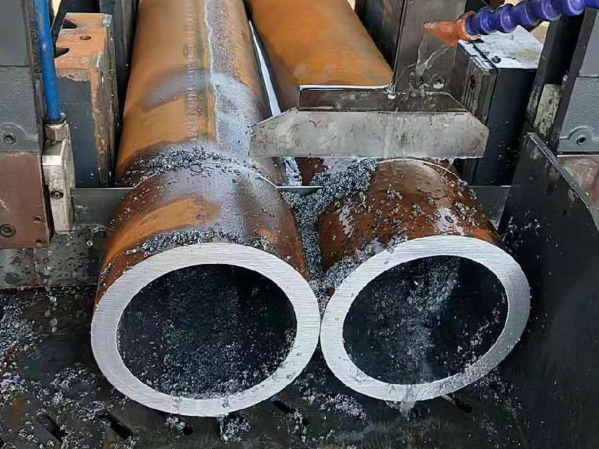
(1) Flame cutting method
This cutting method has the lowest operating cost, but consumes more fluid seamless pipes and the cutting quality is poor. Therefore, manual flame cutting is often used as an auxiliary cutting method. However, due to the improvement of flame cutting technology, some factories have adopted multi-head flame cutting machine automatic cutting as the main method for cutting fluid carbon steel seamless pipes.
(2) Shearing method
This method has high production efficiency and low cutting cost. Medium-carbon seamless pipes and low-carbon alloy structural steel pipes are mainly cut by shearing. In order to improve the shearing efficiency, a large-tonnage shearing machine is used for double shearing; in order to reduce the flattening degree of the end of the steel pipe during cutting, the cutting edge generally adopts a shaped blade. For seamless steel pipes that are prone to shear cracks, the steel pipes are preheated to 300°C during shearing.

(3) Fracture method
The equipment used is a fracture press. The breaking process is to use a cutting torch to cut all the holes at the predetermined breaking liquid pipe, then put it into a breaking press, and use a triangular ax to break it. The distance between the two points is 1-4 times the diameter Dp of the tube blank.
(4) Sawing method
This cutting method has the best cutting quality and is widely used in alloy steel pipes, high-pressure steel pipes, and fluid seamless pipes, especially for cutting large-diameter fluid seamless steel pipes and high-alloy steel pipes. Sawing devices include bow saws, band saws and circular saws. Cold circular saws with high-speed steel sector blades are used for cold sawing alloy steel pipes; cold circular saws with carbide blades are used for high-alloy steel saws.
Precautions for carbon steel pipe cutting:
Other steel pipes can be cut with oxyacetylene flame.
Precautions during cutting:
Safety protection:
Wear goggles and gloves to avoid spark burns.
Keep away from flammable materials during thermal cutting and keep good ventilation.
Cut treatment:
Remove burrs (file/sandpaper polishing) to avoid scratching the seal.
The oxide layer needs to be removed after thermal cutting (pickling or mechanical polishing).
Precision control:
Marking positioning, use a clamp to fix the pipe to prevent deviation.
Selection suggestions:
The method of cutting carbon steel pipes mainly depends on the pipe diameter, wall thickness, precision requirements and site conditions.
Small diameter thin-walled pipe: pipe cutting machine or grinding wheel cutting (economical and fast).
Large diameter thick-walled pipe: plasma or flame cutting (efficient).
High precision requirements: laser cutting or sawing machine (factory prefabricated).
Balance efficiency, cost and quality according to actual needs.
Read more: Carbon Steel Pipe Dimensions and Weights
